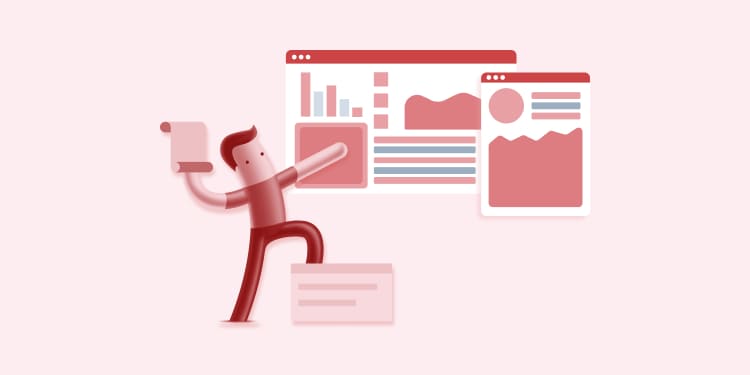
The absolute first thing you need to know about design thinking is: it’s customer-centric. Instead of looking from the outside in (the business’ point of view), it works the other way around.
Stanford University Professor and founder of design firm IDEO, David Kelley defined Design Thinking as:
A human-centered approach to innovation that draws from the designer’s toolkit to integrate the needs of people, the possibilities of technology, and the requirements for business success.
Design is a concept used most often used to describe a product, object or end result. Design thinking takes that up a notch by offering a protocol for solving existing problems and uncovering new opportunities.
Definitions around the theme, as well and the tools and methods used to apply it may vary. However, one thing is true: when used effectively, design thinking can create a steady foundation for skyrocketing a business.
Complex problems demand complex solutions
Today’s organizations face much more complex problems derived mostly from their increasingly complex business models. The current evolution of today’s market offers a lot of advantages but along with unique opportunities come unique challenges.
These challenges are not as common as the one’s companies faced and, therefore, demand more complex, multidimensional solutions.
Keeping your company relevant demands innovation and disruption.
Those factors are responsible for driving growth and achieving a higher profit. Companies are no longer dealing with basic application issues for their current products and services. They’re facing multi-faceted issues that demand a special type of solution.
This scenario is where design thinking comes into the picture: by offering businesses a simple framework, design thinking allows them not only to tackle everyday challenges but also to gain a competitive edge.
In its simplest applications, design thinking is a process of creating and testing innovative ideas to improve a product/service or solve existing problems.
Design thinking provides people with a “generic” framework and its application to all areas of expertise of your company and on the market. It’s not limited to technology or product development: it can be as effective in these areas as it can be in service management or manufacturing.
The design thinking processes can have varied outcomes: new and improved products or services focused on your customer experience as well as improved management techniques and processes to boost your company’s internal productivity.
For not being constrained to one area or another, design thinking can be the way for transforming all your company’s teams, from sales and finance to marketing and operations, turning them into profit centers.
Focus on the customer
According to David Kelley’s definition of design thinking, which we presented at the beginning of this article, we can extract the three main elements of a product or solution: people, technology, and business.
These three aspects must revolve – and evolve – around the customer. The customer is the driving force that moves the present and future of every business. Products or services, focused on internal or external customers, all of them must create a unique value and be focused on specific business needs.
None of this is possible unless the customer is involved as an integral part of the entire product/service lifecycle instead of just considered a commercial goal.
It has been proven by several types of research that companies, teams, or projects that don’t drive their efforts focused on their target customer are bound to fail.
Design thinking puts the customer in the spotlight. It seems rather logical to focus on pleasing the one you wish to please, but many companies have made the mistake of not considering their customer a part of the development equation (and failed miserably because of that).
Multidisciplinary approach
Design thinking is all about consistently applying values embraced by this concept: empathy, diversity, and ambiguity. These reinforce the necessity of creating multidisciplinary teams among companies to focus on the customer’s needs from each and every angle.
These values reflect ideas derived from well-known principles or best practices. What design thinking does is incorporate all of them into a concise, coherent, and repeatable process.
The design thinking process
The design thinking process, whether used to innovate or solve a problem, whether applied to a product or service, consists mainly of four actions.
1. What’s the problem?
As it is with most things, the first step is the most important.
Even though defining a problem may sound simple, doing it right is key for a successful design thinking process.
It’s less about explaining a problem and more about defining the right problem you must solve. In the design thinking process, observing the situation and the existing scenarios is mandatory.
Observation is essential to help form solid ideas and perspectives of the reality. It’s one thing being told what people do, it’s a completely different one to observe them do it and take note of all the details.
It allows you to think outside the box and really experience the product, service or process you’re trying to improve. You won’t really be able to tell what is it that needs improving unless you experience it.
The problem definition phase of design thinking requires observation from multiple perspectives as well as constant (and sometimes relentless) questioning.
Do you remember when you were a kid and you just couldn’t stop asking questions wanting to know all the “whys”? This method of relentlessly questioning makes it a lot easier to observe all variables and reveal the true issues.
Take into consideration that the choice of words for defining a problem is very, very important. What you mean won’t be what people understand unless you say it in a way they can understand it.
As a marketer and content producer, I can safely say: words are tricky, they can be your best friend or your worst enemy.
The main goal of this stage is to identify the right problem you need to solve and present it in a way to invite innovative and disruptive solutions.
2. Two options are better than one:
It’s easy to fall into a cycle and always try to solve a problem the same way.
It’s insane, though, to try the same thing every time and expect different results.
When an existing easy solution would help present successful results within the reduced time frame they have, people tend to stick to what they know is safe instead of innovating. That goes entirely against the purpose of design thinking.
In the design thinking process, no matter how easy or obvious the solution might seem, many alternatives must be created for consideration.
Going back to step 1 and adopting different perspectives of observing a problem really helps when trying to develop innovative, outside the box ideas to solve it.
More often than not we’re not even aware of the constraints we face when presenting answers to problems. Counting on multiple perspectives from a multidisciplinary team is crucial to recognize all existing opportunities to solve a problem.
Design thinking researchers have proven that it’s a lot more likely to gather good ideas from 5 people working together for a day than one person working at it for 5 days.
3. Define and refine:
Even the strongest of new ideas can be fragile it’s not embraced and nurtured until it’s applicable. If an idea is not given a chance to grow protected from its nemesis, the previous experience, it can fall before it even stands up.
Design thinking exists to let each opportunity grow to its potential – it creates an environment that allows ideas to be nurtured. It’s essential that your work philosophy stimulates out of the ordinary results, only then you’ll be able to think outside the box and be bold enough.
The design thinking process is not linear so it’s perfectly fine if you find out you need to go back to looking for options if you realize the ones you’ve been working on aren’t exactly what you need.
4. Put words into action:
After creating and nurturing your winner idea, it’s time to put it into action and see how well it works in real life. Figure out all the resources you’ll need in order to operationalize the idea and get to work.
The road to success in design thinking consists of a combination of a great idea and a great execution. Prototyping a solution and considering all possible scenarios is key in this stage so you’re sure all your bases are covered.
Other design thinking experts may describe the design thinking process in a different way, breaking it down into three, four or even seven stages, such as Herbert A. Simon described it.
Simon’s phases of the design thinking process (define, research, ideate, prototype, choose, implement and learn) were the ones we’ve used as basis for our Design Thinking Template but at the end of the day, it doesn’t really matter how you choose to divide it, the process all comes down to different views of the same process that’s coherently presented results over the past years.
World-renowned designer Charles Eames once said:
Design depends largely on constraints.
For the design thinking process, that’s especially true: in order to think outside the box, you need to first define the restrictions presented by the box. That’s the only way you can “force” yourself to be creative and disruptive enough to be successful.
As described before, design thinking is not just a way of innovating, it’s a defined, repeatable process that is proven to deliver consistent results (likely exceeding initial expectations).
Extraordinary results demand extraordinary thinking, that’s why design thinking is such an important methodology a growing number of businesses are embracing to improve themselves and gain their competitive edges.
Use Design Thinking with Pipefy!
As we’ve mentioned more than once before, design thinking is a defined, repeatable process and, for that reason, we’ve decided to build a comprehensive, widely adaptable process template to provide companies worldwide with the wireframe to start thinking outside the box and creating extraordinary solutions.
Pipefy’s Design Thinking Template is ideal for creating innovative strategies, understanding your customers, and solving day-to-day problems in a dynamic way.
Design thinking is a human-centered process and using this template you will centralize all the information and won’t lose any data!
It’s divided into 6 phases (emphasize, define, ideate, prototype, test, and reflection) to help your company go through all the stages of the design thinking process and produce outstanding innovative results.





